Battle of Kasserine Pass GB, AMT 1/48 scale P-40 F short tail version, 57th Fighter Group North Africa
I want to start out by saying this... I owe a great big "Thank You" to David Thomas, for having a wonderful idea to start this Group Build. David tirelessly commented on our builds, encouraging us as we went along. David was also building his own plane for the Group, which is a plane you don't normally see, The A-20 in 1/48 scale. If you haven't taken a look as to what is happening over there at the Kasserine Pass GB, I highly recommend you do. You're missing out on some good stuff if you don't !
David made a good idea into a great idea by opening it up to include all of North Africa. This gave us all even more possibilities for building subjects that we may not have built otherwise.
Here is the first subject I completed for the Kasserine Pass Group build. It represents a fighter flown by the 57th Fighter Group. The 57th Fighter Group was attached to the 112th RAF Squadron, which also flew P-40's with the now famous "Shark Mouth" on the nose of their planes .
The 57th participated in what come to be know as the "Palm Sunday Massacre", (sometimes called the "Goose Shoot"), where a large number of German Ju-52 transports were intercepted and shot down. Many of the damaged transports (and some of the fighters providing escort), crashed into the Mediterranean Sea.
A small number of German planes managed to limp through to the German Airfield which was the intended destination.
Here are a few articles I found online that describes that day on April 18th, 1943. Exactly one year earlier to the date, the famous Doolittle raid happened over Japan. This is the final event that broke the will of the German military in North Africa. Having no supplies, they had no means left to fight. They were out of fuel, ammunition, medical supplies, spare parts, water and food.
North Africa was abandoned by the Germans and Italians less than 30 days later...
Once the straggling German planes arrived, many more of the surviving transports were immediately placed in the scrap yard due to damages inflicted by the 57th. Later when the German airfield was captured, a TIME magazine reporter was there and snapped these amazing color pictures of the scrap planes that were lying all around.
The scene was also photographed by various Allied personnel. Here's another picture with a caption below it. However these are not Ju-88's. They are Junkers Ju-52's.
As I mentioned before, I was not able to locate any pictures of this exact plane. However I did find some online that you may find interesting. These pictures came from the 57th Fighter Group website, and were posted by members of the group, or their surviving relatives.
Here you can see plane number #56, which is three numbers away from the plane I built, which was #53. The top sides of the plane appear to be a light colored finish. A second camouflage color is used on this plane. This one could have been painted in the US equivalents to RAF Middle Stone and Dark Earth.
Traces of the yellow surround on the US National insignia on the side of the fuselage can be seen in this photo. The yellow surround was applied to U.S. planes insignia as part of Operation Torch.
In this P-40 photo showing a plane that nosed over on landing, you can see the spinner is a darker color. I opted to paint mine red, as this color match the spinners of the 112 RAF Squadron. The kit instructions would have you paint the spinner white. I did not do this as many of the Axis planes had white spinners. I personally think this is an error on the kit instructions. The spinners could have been a Middle Stone or even an Olive Drab color. If you look closely, you will see the letters "US" on the bottom side of the wing, just outboard of the wing mounted MG's. The word "ARMY" would have been used on the other side.
Here is another picture of a P-40 from the same unit. Again this one has a darker colored spinner.
Maintenance was primitive but it had to be done. This picture shows a P-40 undergoing a wing swap. Parts were often cannibalized from a plane that was no longer considered airworthy and used to keep other planes flying that could be salvaged. This was a common practice on all sides throughout the War.
Here again, if you look close, you will see the under wing "US ARMY" lettering. This is why I chose to add the lettering to my build, as I think it was present more often than not.
Here is a painting by Keith Ferris, that depicts the "Palm Sunday Massacre". It kind of gives you a general idea as to what happened.
It is the older AMT kit. The fit was spot on. I didn't have to use filler anywhere on the model. This kit sometimes gets a bad review, but luckily for me it built up rather well...
Overall I was pleased with how this one turned out.
It was painted using Model Master enamels, and the kit decals were also used.
Once the overall sand color was painted, I sealed the top coat and decals with some Testor's Dullcoat.
Weathering was done with a combination of chalks and artists oils.
Tamiya weathering decks were also used.
The exhaust staining was done using a cotton swab.
Burned gun powder residue was also lightly applied using the same method with cotton swabs.
These pictures give you a good general view of the plane.
Here is a photo of the underside of my model, showing the "US ARMY" lettering.
This plane was built at the same time as my other P-40 "Light House Louie", using my assembly line method...
Here's a link to the building process on both planes.
Again I wish to thank David for starting this fantastic Group Build, and the staff from Imodeler for giving us the opportunity to post our builds.
As usual,
"Comments are encouraged"...
Thank you.
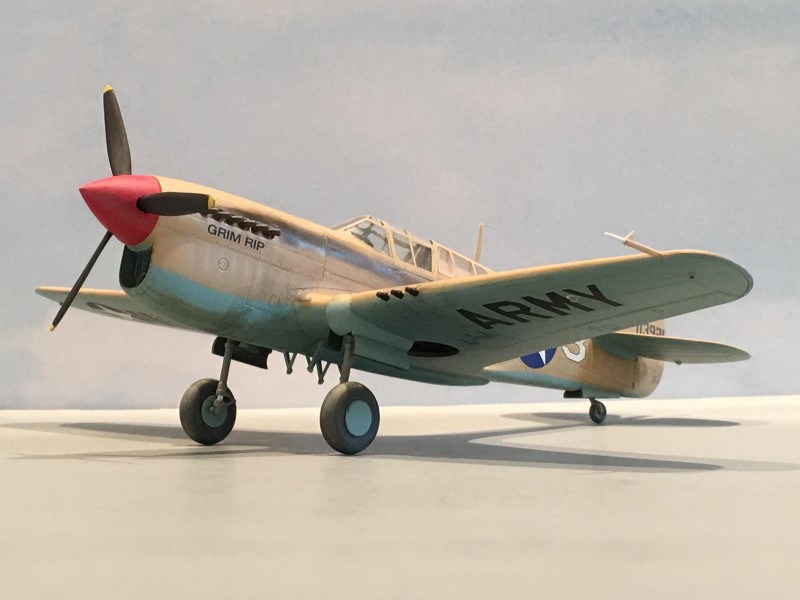
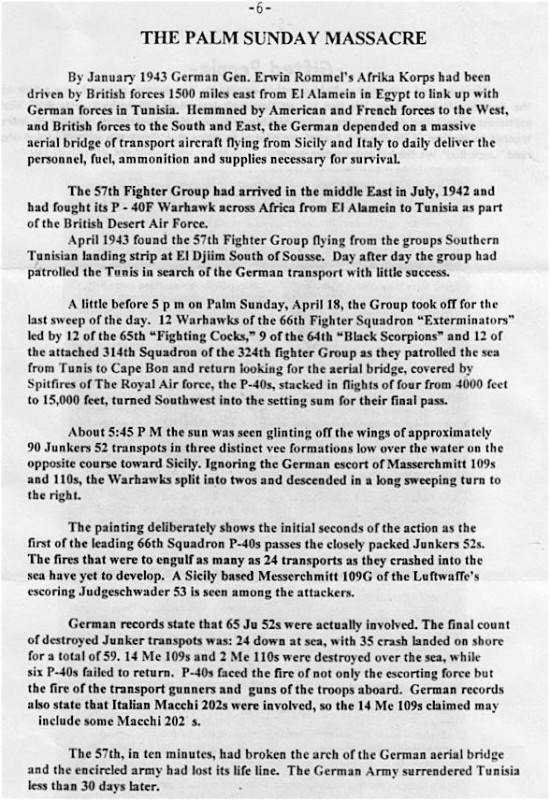
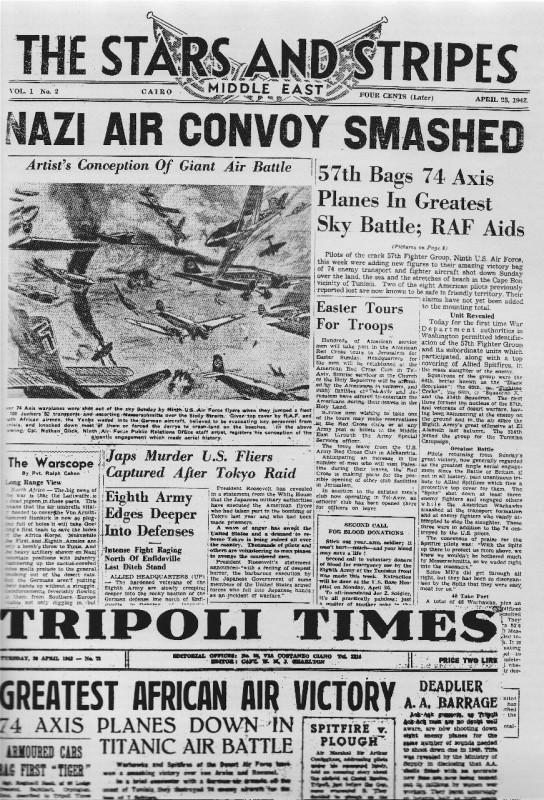
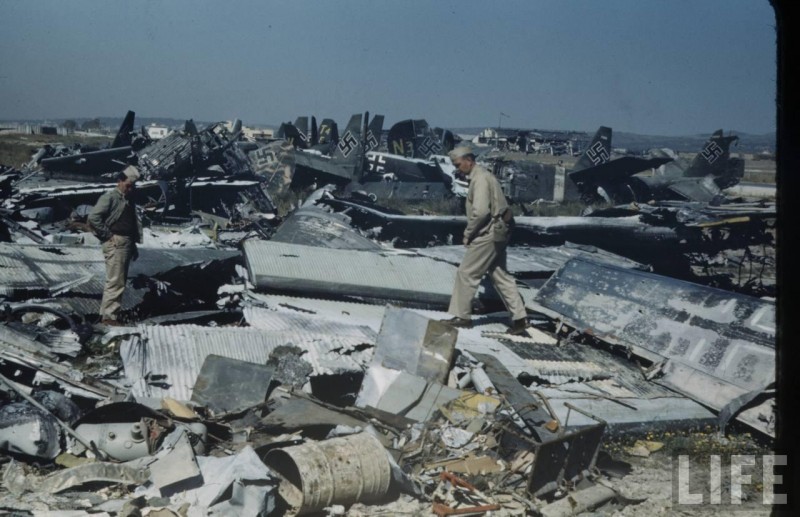
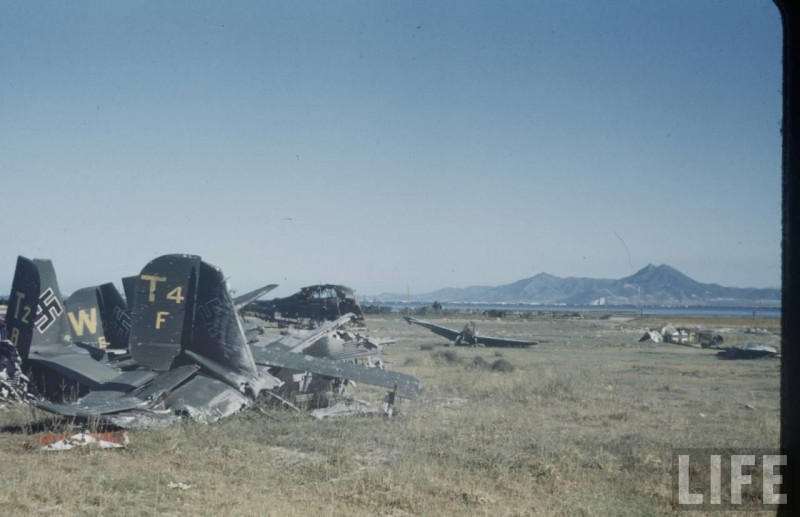

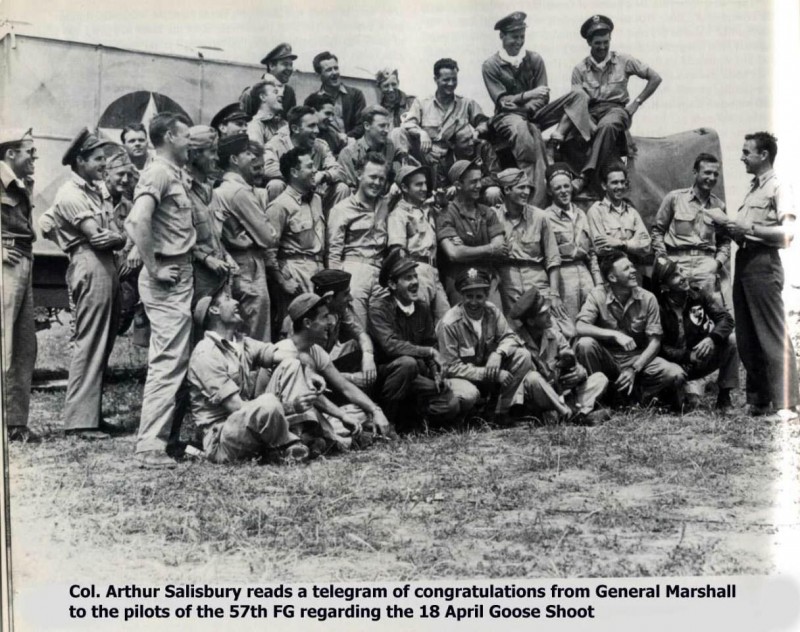
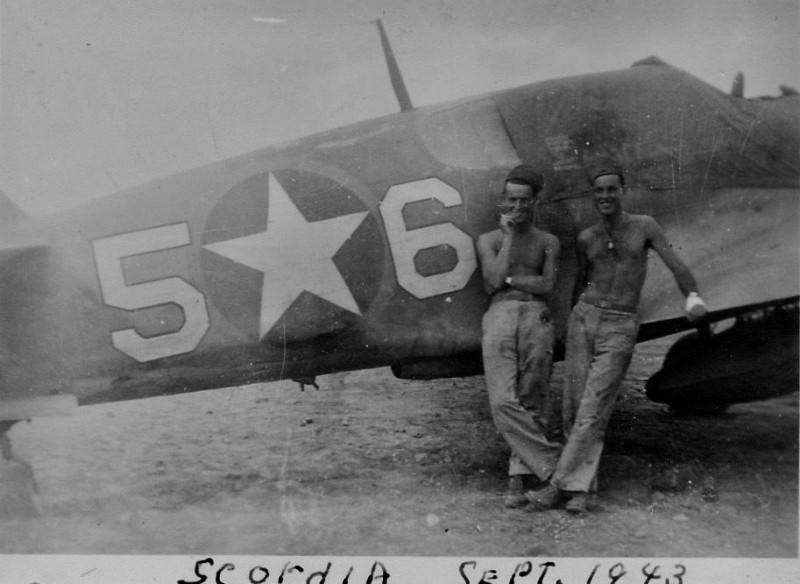
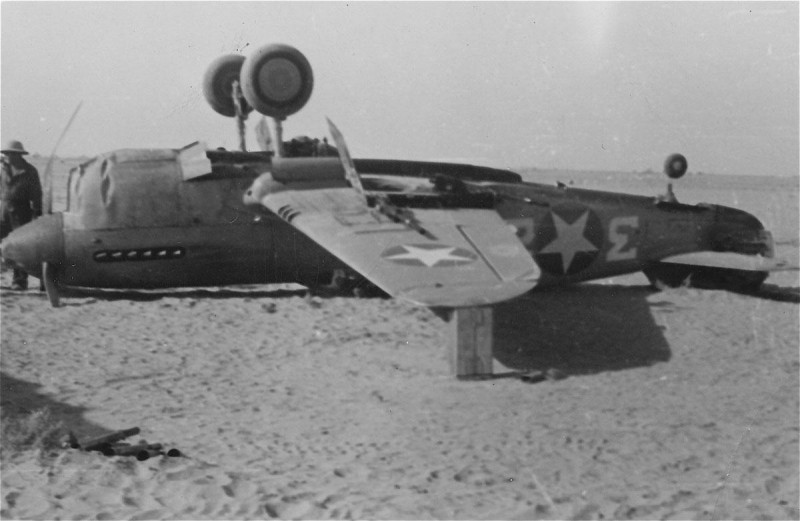
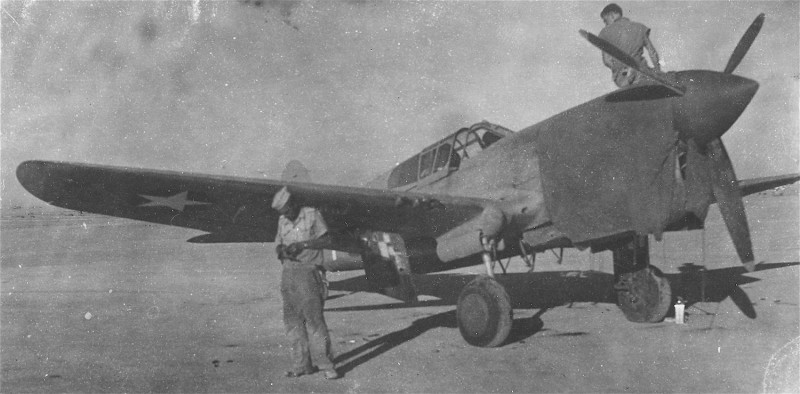

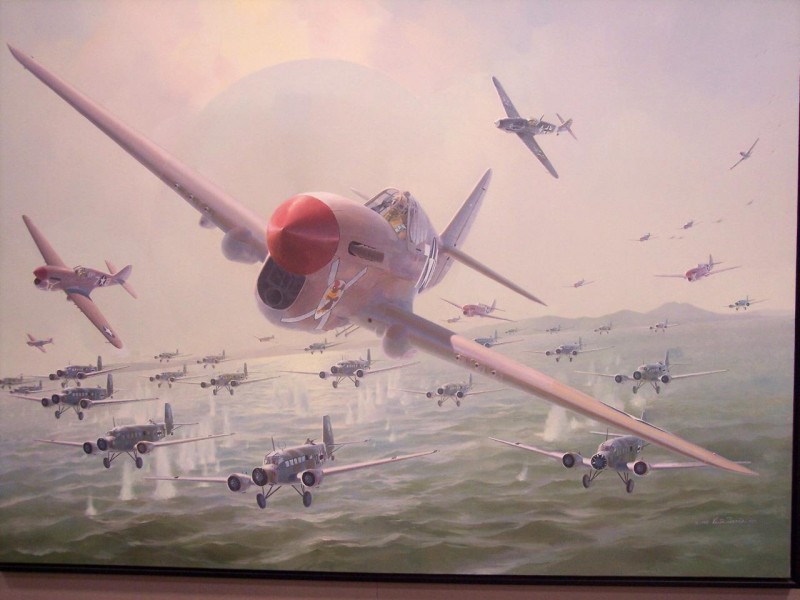
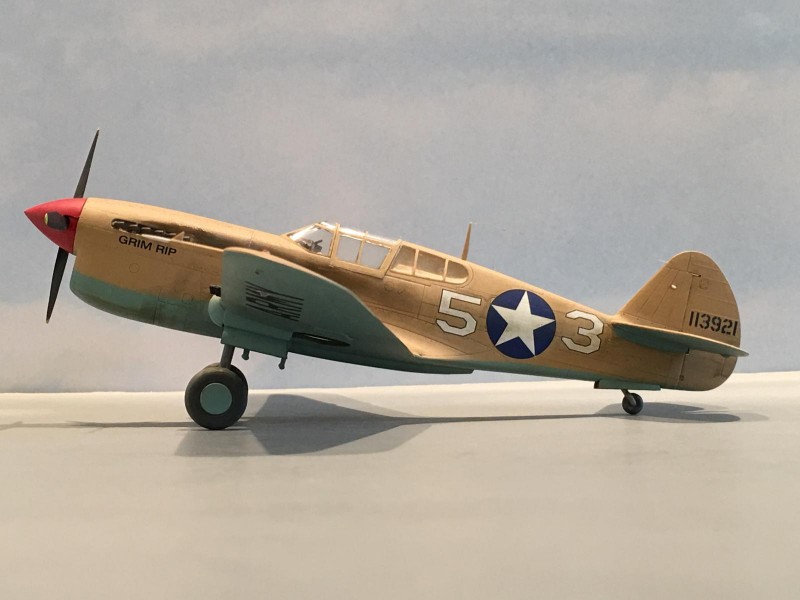
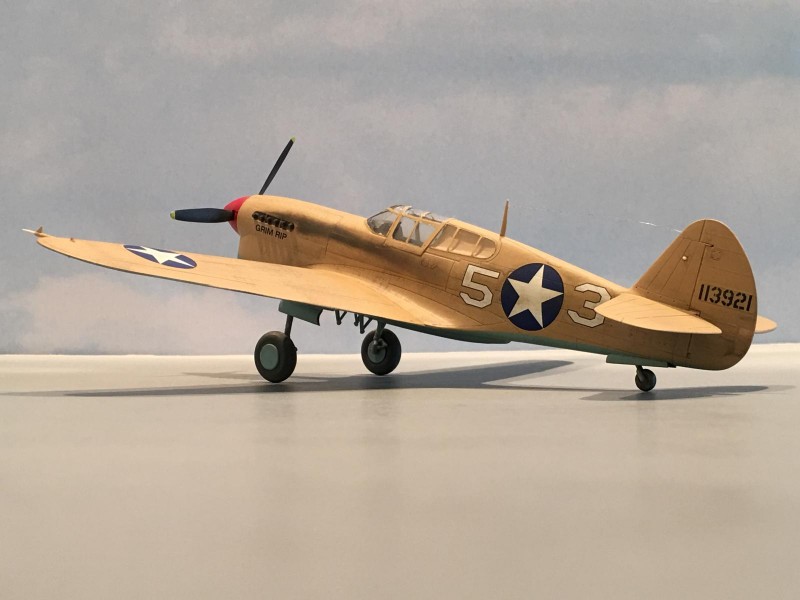

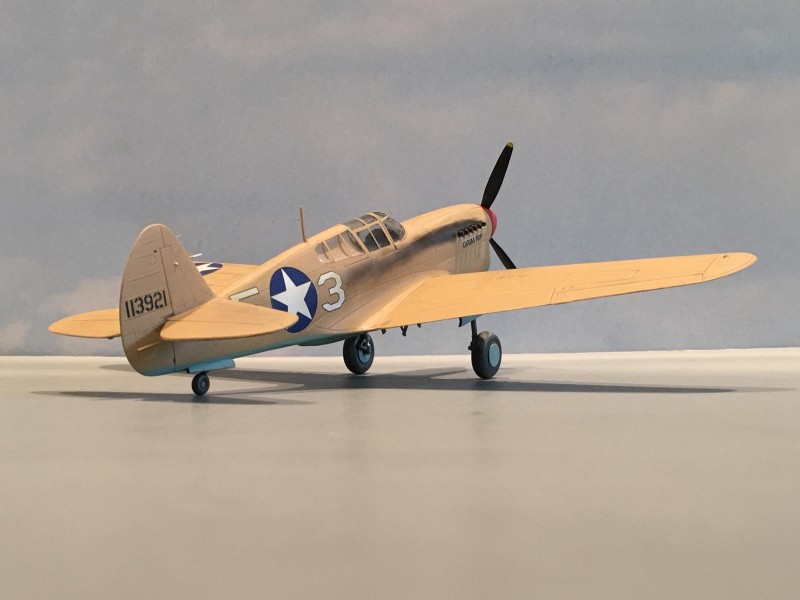
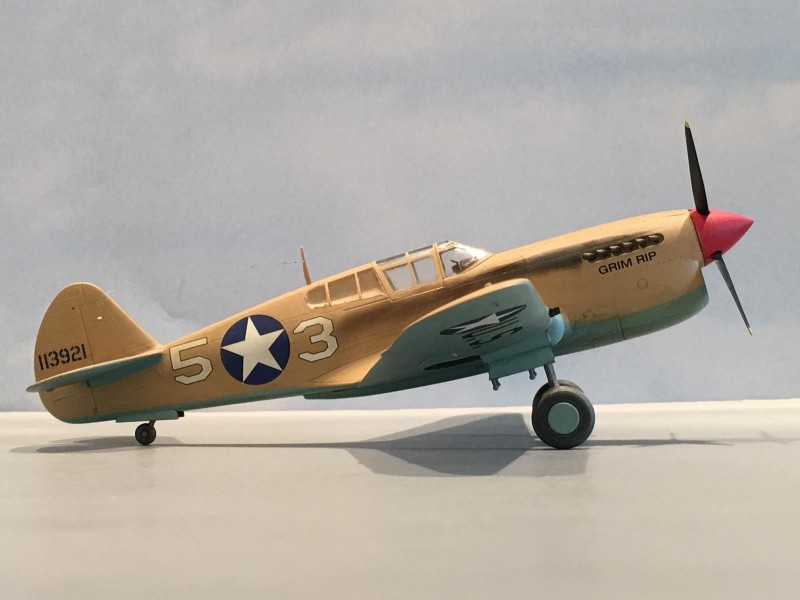
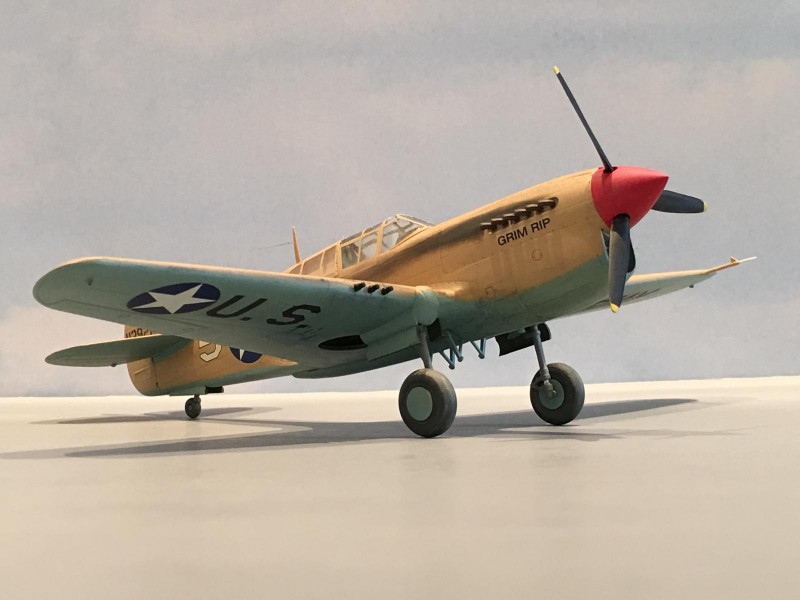
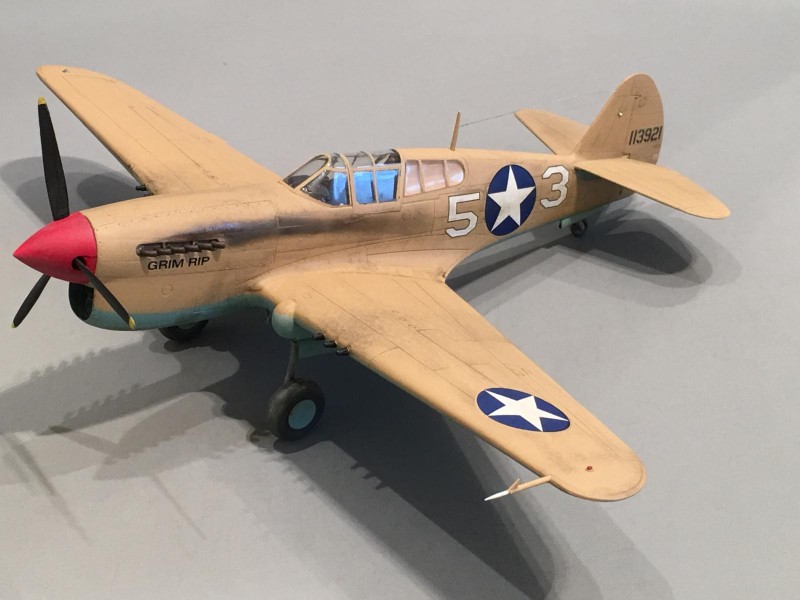
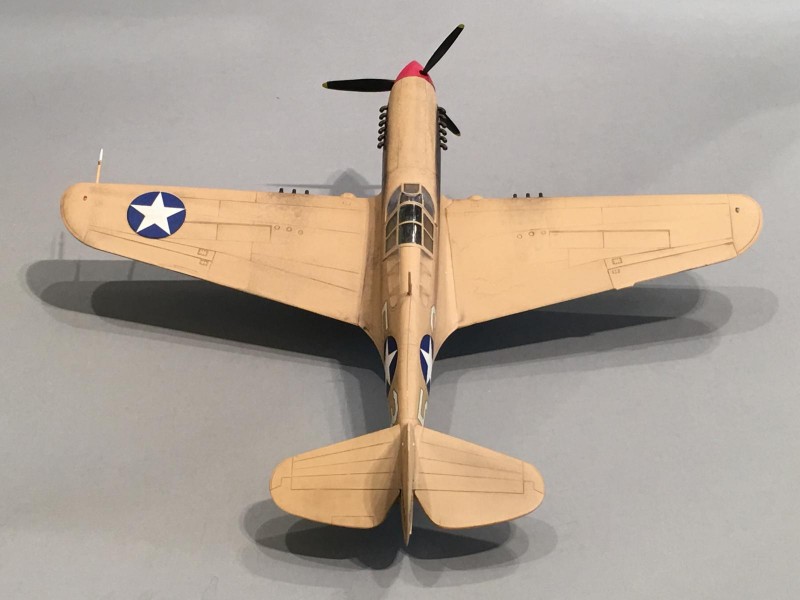
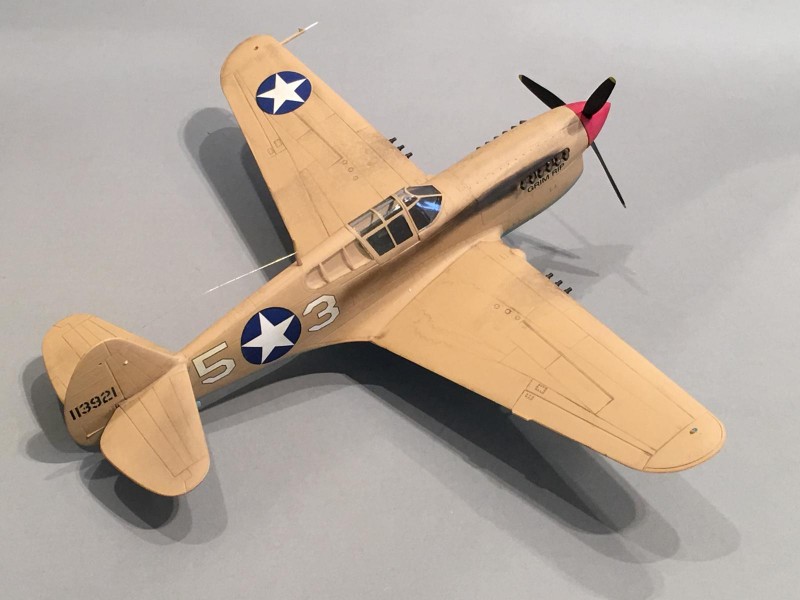
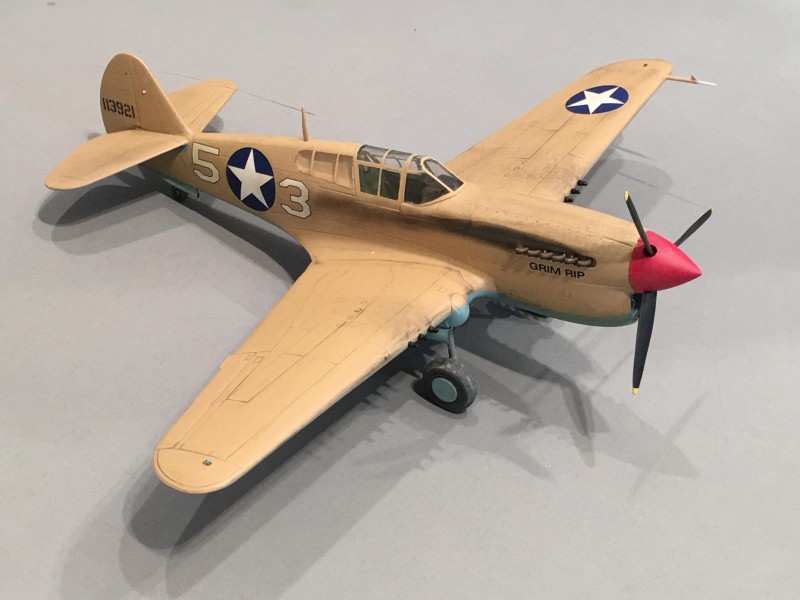

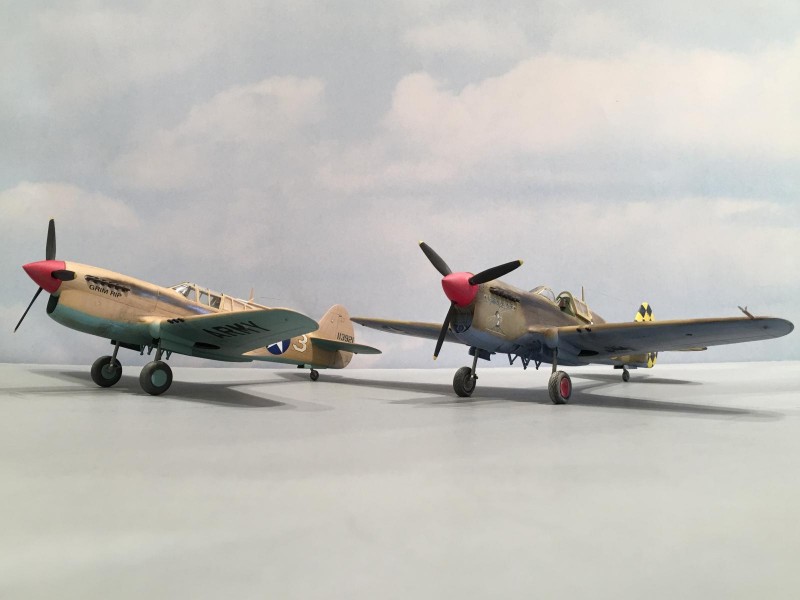
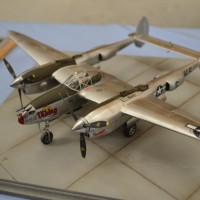
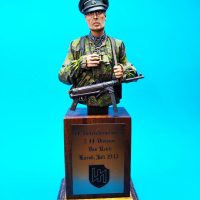
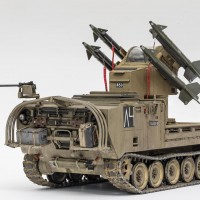

Nicely presented article AND build, Louis...(what's that blue thing in just one of the photos...sun shade for the cockpit - or am I seein' things)?
Thanks Craig ! The blue thing is a reflection on the pilot's windscreen from a window that is nearby where I took the pictures. It is showing the sun light coming into our house from outside.
Good eye buddy !
Louis, you have surpassed yourself here. Excellent sorry and background with great photos. And that Warhawk is impeccable, I really like the way you have finished her - the headline photo in particular is gorgeous.
As ever, thanks for sharing and entertaining, Louis.
Thank you David. I sincerely appreciate the comments my friend. I'm glad you liked It ! I had a good time building it, so that's a win / win ... This is a scheme that was didn't have in my growing P-40 collection, and I wanted to do one in overall sand colors.
This is a scheme that was didn't have in my growing P-40 collection, and I wanted to do one in overall sand colors.
Excellent Louis, I do like that desert scheme on the P-40, also a unique one that you don't see much of. Most with the Shark mouths with camo. The AMT kit doesn't get much fanfare but it is a decent kit. Also the pics showing the conditions in the desert gives life to the model itself. Real machines with real men at war. Well done presentation. Thanks for sharing.
Thanks Chuck !
I agree this AMT kit is a good one. It goes together easily, and on my sample the fit was spot on. I was very happy with how this kit turned out.
Once I read about the Palm Sunday Massacre, I knew had to build a plane that was involved in the event. Luckily I had this one in the stash that fit the bill. It looks good sitting next to my growing collection of P-40’s and is very different from the others by having a sand colored upper surfaces.
Man and machine. You nailed it buddy………. Thanks again !
A great build indeed! I recognized the markings as soon as I saw it, a profile of it is in an old Arco-Aircam publication I've had for years, You've brought it to life for me, great job! I agree with you about the nose color even though the profile shows white, small photo is of your bird I think.
2 attached images. Click to enlarge.
Robert,
Thank you very much for posting these pictures. The P-40 in the center is the same plane ! Now I feel much better, since the instructions had you position the rear number higher than the front one. I was unsure of that, but I went with it anyhow, following my "gut" instincts. This picture shows it is correct...
I think I got the nose color right, since many Bf-109's and Macchi MC 202's were flying around with white noses. The color of the spinner may have been used as a recognition marking, similar to the yellow leading edge used on the wings of British and Japanese aircraft a little later.
Thanks again for posting these !
This post is just the total package, Louis, and everything I love about this site and working with experienced modelers such as yourself. It's got the history down and told in a such a way as to capture and retain the interest of the reader. You have copious photos from all angles. You tell us how you did what you did to achieve that look (and boy, do I need to work on my weathering!). You explain why you opted away from the kit's instructions. This is modeling, rather than mere kit assembly.
I'm very grateful for your kind words, since it is you and others in the GB who have been so generous with their time. What you present here is not only a fun project and a work of art for your own collection, but a service to us all in terms of iModeler and the group build. Your a real prince, and I am very thankful. Congrats and the achievement!
David,
I have enjoyed myself immensely with this group build that you have hosted.
I constructed some planes that I probably wouldn't have done otherwise. I still have a little more work to do on my two 1/35 scale Armor subjects, the (Sherman and the Panzer III). As soon as I complete them I will post them up as well. Please stay tuned as I am getting ready to post "Light House Louie" next...
Receiving such a compliment from you is an honor. Thank you very much Sir !
I sincerely mean that. You too are an accomplished modeler. I have seen your A-20 come to life in the Group Build section. All of the scratch building and attentions to the little details make it stand out. It is a work of art !
Thanks again for hosting this wonderful Group Build my friend.
excellent work Louis!
Thanks Paul !
Great build and research Louis! I'm amazed about this 'turkey shoot' at Europe's doorstep. A fine addition to David's GB!
Thank you Michel ! This "Massacre" was something that many don't realize happened. I'm glad you liked it my friend.
Good job Louis, for a DAT that P-40 really looks great. I'm familiar with the Palm Sunday Massacre and the colossal beating the Luftwaffe took that day. All daylight resupply operations were halted after news of the aircraft losses were reported up the chain. Good story mixed with great pics and a fine looking P-40. Have built several AMT P-40's and like you I found them to be great little kits. Add some after market wheels and a seat and they look look the part. Look forward to seeing that checker board bad boy as well.
Not too bad for a DAT, huh Tom ?
The P-40 is one of my favorite all time planes. The Checker tail P-40 is coming up next. I used replacement resin wheels on that one. Both of these builds could have benefited from a resin seat...
You're absolutely correct about Palm Sunday.
Thanks again buddy !
The two planes look great together Louis - another really accomplished build! I especially enjoyed the blend of newspaper/report/photos that you used - the whole compilation is a 'stand out'. Congratulations!
Thanks Paul for the kind words. I sincerely appreciate this. I was lucky in that I found as much information on the subject that I did for the article. The internet is an awesome library... occasionally.
Thanks again my friend.
Nice work, Louis. I built one of those a few years ago. All of the AMT P-40s are still worth building.
Thanks John. These kits do build up rather well. I had fun on this one.
Right now I have started two Hobby craft / Academy 1/48 scale P-36 kits. I hope they are as much fun as these AMT P-40's were.
Louis, A wonderful looking P-40, and a great read from your article. Well done !
Thanks Terry ! I sincerely appreciate the compliments buddy.
Does anyone believe the transports were intercepted after a Ultra decoded enigma message warned the Allied forces? Where did the intel come from? Any views?
Hello Michel. I watched a TV program the other night and they were talking about how the British were actually reading the radio messages before Rommel was. Then Rommel's encryption unit was captured which dealt him another blow. It turns out that the Germans were reading messages that were being sent back to the US by an unsuspecting American officer. He was giving details about everything and adding his personal comments about how effective the British were (or were not) effective. Once this was realized the American forces started sending out false information in hopes that the Germans would think it was true.
I personally think that this Palm Sunday Massacre happened as a direct result of reading ultra messages. I know the Allies were intercepting U-Boat Wolf Packs during this time as well by using information about the location of the subs provided by the ultra messages to Admiral Dornitz.
It makes sense to me that this event was done by reading the messages and acting upon them.
Good question.
I would really like to hear more about this so if anyone else has more comments to add it would be great.
Louis, David Kahns' The Codebreakers, and The Game of the Foxes. (can't remember the author) Also, F.W. Winterbotham, The Ultra Secret. In England, the folks at Bletchley (no, that's the name, British, what?) and in the U.S. Arlington Hall Station. Fascinating reading. Any of those, check the bibliography, for additional reading. When I was in the Army, I worked in the field. There is a unit page, look for USASSG ACSI DA.
Thanks for the input Bernard. This also is a very important behind the scenes type operation... I'll see what I can scrounge up for reading on the subject.
Pure, dead brilliant ! As the Pythons might say ...
Like the others, I really admire the desert camo you've shown here. Plus, red spinners are waaaay cool. I do believe they were helpful for aircraft ID. We didn't do it so much when I joined the Army, but before I left each Platoon had it's own color.
Red - 1st Platoon
White - 2nd Platoon
Blue - 3rd Platoon
4th Platoon - if needed was Green
... and Headquarters Platoon - Black
Combine that with the numbers codes used - 6 was always the Commander
5 - the Executive Officer
7 - Platoon Sergeant or 1st Sgt.
etc. - during Desert Storm I was Green 7.
Perhaps the spinner color indicated the flight # or company or position (flight leader, etc.)
I like red & yellow best.
Thanks Jeff ! I appreciate the compliments on this build.
We had another number that was used to designate a position.
The Platoon Sgt. was a 9. For a while I served as a gunner in White 6, which was a section Sgt. vehicle from 2nd Platoon, then in White 9, which was the Platoon Sgt.'s track (also from 2nd Platoon).
As always, it's great to hear from you bud...
Our CO was always 66.
The red spinner was used in Africa before we got there, by the British. It was an identification feature, like the German white fuselage bands and wing tips. We used the British ID, plus their fin flash, on various of our aircraft. As a note, RAF insignia red is more tomato colored than our red.
That's what I thought too. This is why I chose to paint the spinner red on this one, which went against what the kit instructions stated. The instructions would have you paint the spinner white. I think this was based on an artist's rendering that Robert Royes provided with his answer. Errors have happened in this fashion more than once for me. And I always seem to find out after I have finished the model. That's why now I try so hard to locate an actual photo of the subject I am building, even if it's only a partial...
Thanks again !
What amazes me is that your "factory assembly line" keeps putting out such excellent product, in spite of what must be multiple strikes and other labor issues! (oh - just the wife...probably a little chocolate to arbitrate that "overtime on the factory floor...")!
Great model, wonderful piece of history, and love both the P-40 and the desert scheme! Excellent!
Ha ha Greg ! Good stuff. The Iron Werks hasn't had too much time on the assembly line lately. Just enough to get the Sherman done... I did post up some kit reviews too.
Chocolate is a good thing to keep on hand...
Thanks for the compliments buddy...
Another result great result, Louis, and a fine addition to the group build.
Thank you George. This Group Build has been very informative for me. I have learned so much about some things I never knew existed...
Take care my friend.
Great build! It was plane from Exterminators squadron from 57 FG?